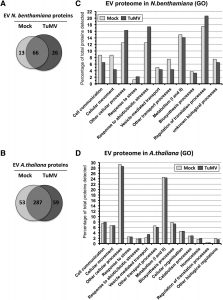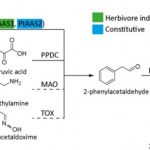Turnip Mosaic Virus is Released into Extracellular Space
Turnip Mosaic Virus (TuMV) is a +RNA virus that belongs to the order Picornavirales. +RNA viruses reorganize the endomembrane system to generate quasi-organelle structures called “viral factories”. In the case of TuMV, these factories are motile vesicles of ~100 nm in diameter that contain the TuMV genome as well as viral and host proteins involved in vRNA replication. These motile vesicles move intercellularly from infected  cells to adjacent healthy cells through virus-modified plasmodesmata until they reach the vascular tissues. In TuMV the endomembrane system of the infected cell is reorganized to generate endoplasmic reticulum–derived motile vesicles containing viral replication complexes. The membrane-associated viral protein 6K2 plays a key role in the formation of these vesicles. This viral protein, which serves as marker for viral replication complexes, is localized in the extracellular space of infected Nicotiana benthamiana leaves. It has also been previously established that viral RNA is associated with multivesicular bodies (MVBs). By means of transmission electron microscopy, Movahed et al. (10.1104/pp.19.00381), have observed the proliferation of MVBs during infection and their fusion with the plasma membrane that results in the release of their intraluminal vesicles in the extracellular space. Immunogold labeling with a monoclonal antibody that recognizes double-stranded RNA indicated that the released vesicles contained viral RNA. The presence of TuMV proteins in the extracellular space was confirmed by proteomic analysis of purified extracellular vesicles from N. benthamiana and Arabidopsis. Host proteins involved in biotic defense and in interorganelle vesicular exchange were also detected. These discoveroes challenge the notion that no viral components, besides viral particles, are found outside of plant cells and implicates extracellular vesicles in the viral infection process.
cells to adjacent healthy cells through virus-modified plasmodesmata until they reach the vascular tissues. In TuMV the endomembrane system of the infected cell is reorganized to generate endoplasmic reticulum–derived motile vesicles containing viral replication complexes. The membrane-associated viral protein 6K2 plays a key role in the formation of these vesicles. This viral protein, which serves as marker for viral replication complexes, is localized in the extracellular space of infected Nicotiana benthamiana leaves. It has also been previously established that viral RNA is associated with multivesicular bodies (MVBs). By means of transmission electron microscopy, Movahed et al. (10.1104/pp.19.00381), have observed the proliferation of MVBs during infection and their fusion with the plasma membrane that results in the release of their intraluminal vesicles in the extracellular space. Immunogold labeling with a monoclonal antibody that recognizes double-stranded RNA indicated that the released vesicles contained viral RNA. The presence of TuMV proteins in the extracellular space was confirmed by proteomic analysis of purified extracellular vesicles from N. benthamiana and Arabidopsis. Host proteins involved in biotic defense and in interorganelle vesicular exchange were also detected. These discoveroes challenge the notion that no viral components, besides viral particles, are found outside of plant cells and implicates extracellular vesicles in the viral infection process.



